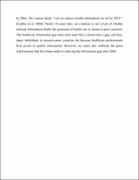| dc.contributor.author | Caleb Van Essen, Caleb Van | |
| dc.contributor.author | Mizero, Paterne | |
| dc.contributor.author | Kyamanywa, Patrick | |
| dc.contributor.author | Cartledge, Peter | |
| dc.date.accessioned | 2022-04-07T14:37:06Z | |
| dc.date.available | 2022-04-07T14:37:06Z | |
| dc.date.issued | 2014 | |
| dc.identifier.citation | Van Essen, C., Mizero, P., Kyamanywa, P. and Cartledge, P., 2014. HINARI grows: one step closer to health information for all. Tropical Medicine & International Health, 19(7), pp.825-827. | en_US |
| dc.identifier.issn | 1360-2276 | |
| dc.identifier.issn | 1365-3156 | |
| dc.identifier.uri | http://hdl.handle.net/20.500.12280/2930 | |
| dc.description.abstract | In 2004, The Lancet asked: ‘Can we achieve health information for all by 2015?’ (Godlee et al. 2004). Nearly 10 years later, we continue to see a lack of reliable relevant information hinder the provision of health care in resource-poor countries. The healthcare information gap often feels more like a chasm than a gap, and thus, many individuals in resource-poor countries die because healthcare professionals lack access to quality information. However, we must also celebrate the great achievements that have been made in reducing the information gap since 2004. | en_US |
| dc.language.iso | en | en_US |
| dc.publisher | Wiley , 111 River St, Hoboken, Usa, Nj, 07030-5774 | en_US |
| dc.relation.ispartofseries | Tropical Medicine & International Health;19(7) | |
| dc.subject | HINARI | en_US |
| dc.subject | Medical informatics | en_US |
| dc.subject | Health information technology | en_US |
| dc.title | HINARI Grows: One Step Closer to Health Information For All | en_US |
| dc.type | Article | en_US |


